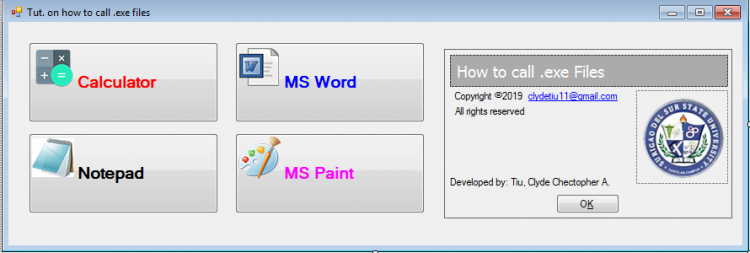How to Call .exe Files Using Visual Basic .NET
Submitted by ClydeTiu on Monday, January 28, 2019 - 13:26.
Language
Hi guys,
In this tutorial you will learn on how to call .exe files.
Source code is downloadable below.
Step 1
First Create a new Project
 Step 2
Create User Interface
Step 2
Create User Interface
 Step 3
In Every button put this code
Step 3
In Every button put this code
 Source Code
Source Code
 Step 2
Create User Interface
Step 2
Create User Interface
 Step 3
In Every button put this code
Step 3
In Every button put this code
 Source Code
Source Code
Private Sub Button1_Click(ByVal sender As System.Object, ByVal e As System.EventArgs) Handles Button1.Click
Try
System.Diagnostics.Process.Start("Calc.exe")
Catch ex As Exception
MessageBox.Show(ex.Message, "Error", MessageBoxButtons.OK, MessageBoxIcon.Error)
End Try
End Sub
Private Sub Button2_Click(ByVal sender As System.Object, ByVal e As System.EventArgs)
Try
System.Diagnostics.Process.Start("Notepad.exe")
Catch ex As Exception
MessageBox.Show(ex.Message, "Error", MessageBoxButtons.OK, MessageBoxIcon.Error)
End Try
End Sub
Private Sub Button3_Click(ByVal sender As System.Object, ByVal e As System.EventArgs)
Try
System.Diagnostics.Process.Start("mspaint.exe")
Catch ex As Exception
MessageBox.Show(ex.Message, "Error", MessageBoxButtons.OK, MessageBoxIcon.Error)
End Try
End Sub
Private Sub Button4_Click(ByVal sender As System.Object, ByVal e As System.EventArgs)
Try
System.Diagnostics.Process.Start("Winword.exe")
Catch ex As Exception
MessageBox.Show(ex.Message, "Error", MessageBoxButtons.OK, MessageBoxIcon.Error)
End Try
End SubNote: Due to the size or complexity of this submission, the author has submitted it as a .zip file to shorten your download time. After downloading it, you will need a program like Winzip to decompress it.
Virus note: All files are scanned once-a-day by SourceCodester.com for viruses, but new viruses come out every day, so no prevention program can catch 100% of them.
FOR YOUR OWN SAFETY, PLEASE:
1. Re-scan downloaded files using your personal virus checker before using it.
2. NEVER, EVER run compiled files (.exe's, .ocx's, .dll's etc.)--only run source code.
Add new comment
- 1219 views

